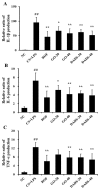Preventive Effect of Garlic Oil and Its Organosulfur Component Diallyl-Disulfide on Cigarette Smoke-Induced Airway Inflammation in Mice
- PMID: 30400352
- PMCID: PMC6267300
- DOI: 10.3390/nu10111659
Preventive Effect of Garlic Oil and Its Organosulfur Component Diallyl-Disulfide on Cigarette Smoke-Induced Airway Inflammation in Mice
Abstract
Garlic (Allium sativum) has traditionally been used as a medicinal food and exhibits various beneficial activities, such as antitumor, antimicrobial, hypolipidemic, antiarthritic, and hypoglycemic activities. The aim of this study was to explore the preventive effect of garlic oil (GO) and its organosulfur component diallyl disulfide (DADS) on cigarette smoke (CS)-induced airway inflammation. Mice were exposed to CS daily for 1 h (equivalent to eight cigarettes per day) for two weeks, and intranasally instilled with lipopolysaccharide (LPS) on day 12 after the initiation of CS exposure. GO and DADS were administered to mice by oral gavage, both at rates of 20 and 40 mg/kg, for 1 h before CS exposure for two weeks. In the bronchoalveolar lavage fluid, GO and DADS inhibited the elevation in the counts of inflammatory cells, particularly neutrophils, which were induced in the CS and LPS (CS + LPS) group. This was accompanied by the lowered production (relative to the CS + LPS group) of interleukin (IL)-1β, IL-6, and tumor necrosis factor-α. Histologically, GO and DADS inhibited the CS- and LPS-induced infiltration of inflammatory cells into lung tissues. Additionally, GO and DADS inhibited the phosphorylation of extracellular signal-regulated kinase and the expression of matrix metalloproteinase-9 in the lung tissues. Taken together, these findings indicate that GO and DADS could be a potential preventive agent in CS-induced airway inflammation.
Keywords: airway inflammation; cigarette smoke; diallyl disulfide; extracellular signal-regulated kinase; garlic oil; matrix metalloproteinase-9.
Conflict of interest statement
The authors declare no conflicts of interest.
Figures





Similar articles
-
Pharmacological Investigation of the Anti-Inflammation and Anti-Oxidation Activities of Diallyl Disulfide in a Rat Emphysema Model Induced by Cigarette Smoke Extract.Nutrients. 2018 Jan 12;10(1):79. doi: 10.3390/nu10010079. Nutrients. 2018. PMID: 29329251 Free PMC article.
-
Diallyl-disulfide, an organosulfur compound of garlic, attenuates airway inflammation via activation of the Nrf-2/HO-1 pathway and NF-kappaB suppression.Food Chem Toxicol. 2013 Dec;62:506-13. doi: 10.1016/j.fct.2013.09.012. Epub 2013 Sep 16. Food Chem Toxicol. 2013. PMID: 24051194
-
Identification of a pro-elongation effect of diallyl disulfide, a major organosulfur compound in garlic oil, on microglial process.J Nutr Biochem. 2020 Apr;78:108323. doi: 10.1016/j.jnutbio.2019.108323. Epub 2019 Dec 17. J Nutr Biochem. 2020. PMID: 32135404
-
A comprehensive understanding about the pharmacological effect of diallyl disulfide other than its anti-carcinogenic activities.Eur J Pharmacol. 2021 Feb 15;893:173803. doi: 10.1016/j.ejphar.2020.173803. Epub 2020 Dec 24. Eur J Pharmacol. 2021. PMID: 33359648 Review.
-
Garlic and its Active Compounds: A Potential Candidate in The Prevention of Cancer by Modulating Various Cell Signalling Pathways.Anticancer Agents Med Chem. 2019;19(11):1314-1324. doi: 10.2174/1871520619666190409100955. Anticancer Agents Med Chem. 2019. PMID: 30963982 Review.
Cited by
-
Garlic oil alleviates high triglyceride levels in alcohol-exposed rats by inhibiting liver oxidative stress and regulating the intestinal barrier and intestinal flora.Food Sci Nutr. 2022 Mar 29;10(8):2479-2495. doi: 10.1002/fsn3.2854. eCollection 2022 Aug. Food Sci Nutr. 2022. PMID: 35959265 Free PMC article.
-
Diallyl Disulfide Suppresses Inflammatory and Oxidative Machineries following Carrageenan Injection-Induced Paw Edema in Mice.Mediators Inflamm. 2020 Apr 15;2020:8508906. doi: 10.1155/2020/8508906. eCollection 2020. Mediators Inflamm. 2020. PMID: 32377166 Free PMC article.
-
The Potential of Natural Oils to Improve Inflammatory Bowel Disease.Nutrients. 2023 Jun 1;15(11):2606. doi: 10.3390/nu15112606. Nutrients. 2023. PMID: 37299569 Free PMC article. Review.
-
Fatty liver and alteration of the gut microbiome induced by diallyl disulfide.Int J Mol Med. 2019 Nov;44(5):1908-1920. doi: 10.3892/ijmm.2019.4350. Epub 2019 Sep 24. Int J Mol Med. 2019. PMID: 31573042 Free PMC article.
-
An Exploratory Review of Potential Adjunct Therapies for the Treatment of Coronavirus Infections.J Chiropr Med. 2021 Dec;20(4):199-217. doi: 10.1016/j.jcm.2021.12.005. Epub 2021 Dec 11. J Chiropr Med. 2021. PMID: 34924893 Free PMC article. Review.
References
MeSH terms
Substances
Grants and funding
LinkOut - more resources
Full Text Sources

